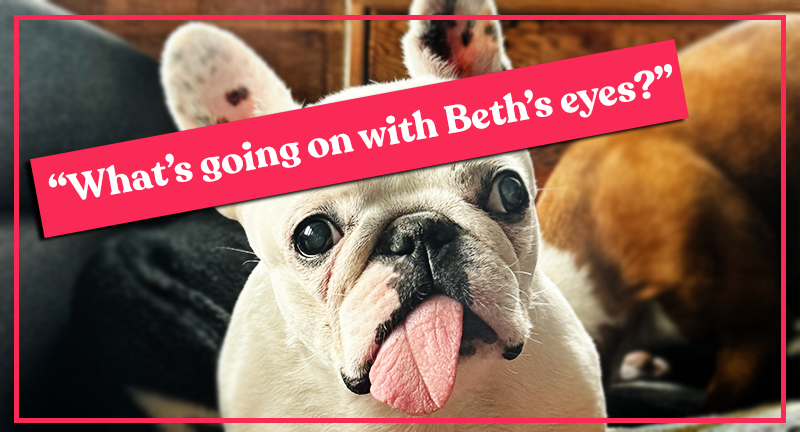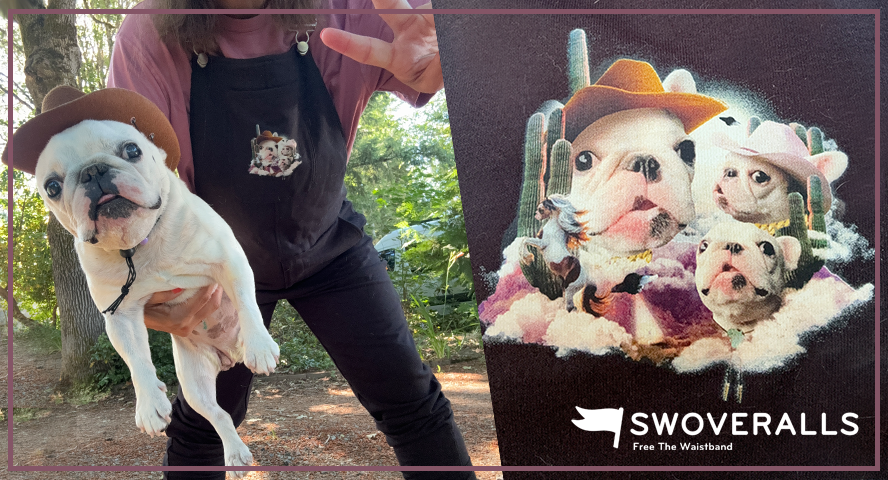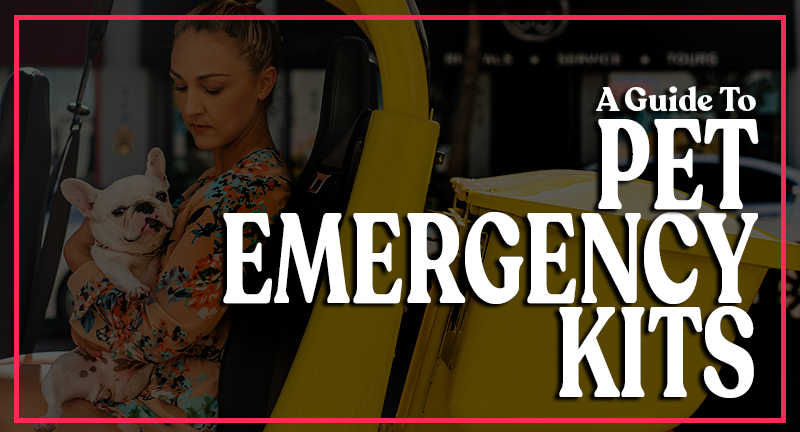Beth’s sweet little dog eyes have been facing some tough challenges lately. Cataracts, dry eye, and glaucoma are making her vision worse, but she’s not letting it slow her down. Cataracts, one of the top eye problems for dogs, cause cloudiness in the lens and can lead to blindness if untreated. Her dry eye, a condition where her eyes don’t produce enough tears, adds to her discomfort. Glaucoma, which increases pressure in her right eye, is another hurdle. Thankfully, medications are helping keep her comfortable. Even though her eyes are lazy in their function, her spirit remains strong.
Key Takeaways
Recognize early signs of eye issues in dogs, such as redness, cloudiness, and excessive tearing, to ensure timely veterinary care.
Regularly clean around your dog's eyes to prevent irritation and infections, using a soft cloth or vet-approved wipes.
Monitor your dog's behavior for signs of discomfort, like squinting or pawing at their eyes, which may indicate underlying problems.
Maintain a balanced diet rich in antioxidants to support your dog's eye health and overall well-being.
Schedule routine veterinary check-ups to catch potential eye problems early and adjust treatment plans as needed.
Consider protective gear for your dog during outdoor activities to shield their eyes from dust, debris, and harmful UV rays.
Act quickly if you notice sudden changes in your dog's eyes or behavior, as prompt action can prevent serious complications.
Common Symptoms of Dog Eye Issues
Signs of a Dog Eye Infection and Other Problems
Your dog’s eyes can reveal a lot about their health. Recognizing the signs of a dog eye infection or other issues early can make a big difference in their comfort and well-being. Here are some common symptoms to watch for:
Redness, swelling, or irritation in the eyes
Redness in your dog’s eyes often signals trouble. It could mean an infection, irritation, or even an allergic reaction. Swelling around the eyes might also indicate a problem that needs attention. If you notice these symptoms, it’s best to consult your vet promptly. As PetMD advises, redness in the eyes is a clear sign that veterinary care is necessary.
Cloudy eyes or changes in eye appearance
Cloudy eyes can be a normal part of aging, but they might also point to a more serious eye problem like cataracts or glaucoma. If your dog’s eyes look different than usual, don’t ignore it. Changes in appearance, especially if they happen quickly, should always be checked by a professional.
Excessive tearing, discharge, or crusting
Tears are normal, but too much tearing or unusual discharge can signal an issue. Yellow-green discharge, in particular, is a common sign of a dog eye infection. Crusting around the eyes might also mean your dog is dealing with an infection or irritation. If you don’t see redness or swelling, watery eyes might not need treatment. However, persistent discharge or crusting should be evaluated by a vet.
Behavioral Changes to Watch For
Sometimes, your dog’s behavior can tell you more about their eye health than the eyes themselves. Pay close attention to how they act, especially if they seem uncomfortable or lazy in their movements.
Squinting, pawing at the eyes, or rubbing against surfaces
Dogs often squint or paw at their eyes when they feel irritated or in pain. Rubbing their face against furniture or the floor is another sign they’re trying to relieve discomfort. These behaviors could mean they’re dealing with dog eye allergies, an infection, or another issue.
Sensitivity to light or avoiding bright areas
If your dog suddenly avoids sunny spots or bright rooms, it might be because their eyes are sensitive to light. This sensitivity often accompanies conditions like glaucoma or severe irritation. Keeping an eye on this behavior can help you catch problems early.
Bumping into objects or hesitancy in unfamiliar spaces
When a dog starts bumping into furniture or hesitates in new environments, it might mean their vision is declining. Lazy navigation or clumsiness could be linked to cataracts, retinal degeneration, or other serious conditions. These changes in behavior shouldn’t be ignored.
By staying alert to these symptoms and behaviors, you can catch potential eye issues before they worsen. Your dog relies on you to notice when something’s wrong, so don’t hesitate to act if you see any of these signs.
Potential Causes of Beth's Eye Condition
Cataracts and Cloudy Eyes
How cataracts develop and affect vision
Cataracts form when the lens of your dog’s eye becomes cloudy, blocking light from reaching the retina. This cloudiness disrupts vision, making it harder for your dog to see clearly. Over time, cataracts can grow larger, leading to significant vision loss or even blindness. The lens, which normally focuses light on the retina, loses its transparency due to protein clumping. This process often starts small but progresses if left untreated.
Connection between cataracts and aging or genetics
Aging plays a major role in the development of cataracts. As dogs grow older, their lenses naturally become less flexible and more prone to cloudiness. Genetics also contribute significantly. Certain breeds, like Cocker Spaniels and Poodles, are more likely to inherit this condition. Studies have identified 29 genetic mutations linked to inherited eye disorders in dogs, including cataracts. If your dog belongs to a breed with a higher risk, regular eye check-ups can help catch cataracts early.
Dry Eye (Keratoconjunctivitis Sicca)
Causes of reduced tear production in dogs
Dry eye, or keratoconjunctivitis sicca, occurs when your dog’s eyes don’t produce enough tears. Tears keep the eyes moist and protect them from irritation. Without enough tears, the eyes become dry and inflamed. This condition often stems from an autoimmune response where the body attacks its own tear glands. Other causes include certain medications, infections, or trauma to the tear-producing glands.
Symptoms and risks of untreated dry eye
Dry eye can cause redness, excessive blinking, and a thick, sticky discharge around the eyes. If untreated, it may lead to corneal ulcers or scarring, which can permanently damage your dog’s vision. Lazy eye movements or frequent pawing at the face might also indicate discomfort from dry eye. Early treatment with medications like Tacrolimus can help manage symptoms and prevent complications.
Glaucoma and Increased Eye Pressure
How glaucoma damages the optic nerve
Glaucoma in dogs develops when fluid builds up inside the eye, increasing pressure. This pressure damages the optic nerve, which is responsible for transmitting visual information to the brain. Over time, this damage can lead to partial or complete vision loss. The condition often progresses silently, making it crucial to monitor your dog’s eyes for subtle changes.
Symptoms of glaucoma, such as pain and vision loss
Dogs with glaucoma may show signs of pain, such as squinting or avoiding bright areas. You might notice cloudy eyes or a bluish tint in the affected eye. Vision loss can cause your dog to bump into objects or hesitate in unfamiliar spaces. Lazy eye movements or a lack of focus might also signal trouble. Medications like Dorzolamide and Latanoprost can help reduce eye pressure and slow the progression of the disease.
By understanding these potential causes, you can take proactive steps to protect your dog’s eye health. Regular vet visits and early intervention make a big difference in managing conditions like cataracts, dry eye, and glaucoma.
Retinal Degeneration
What retinal degeneration is and how it progresses
Retinal degeneration in dogs is a condition where the retina, the light-sensitive layer at the back of the eye, gradually deteriorates. This process disrupts the retina’s ability to send visual signals to the brain, leading to vision loss over time. In some cases, this condition begins early in life, with affected dogs showing signs of poor vision as young as 5–6 weeks old. For others, it develops later, often as part of aging or due to inherited traits.
Progressive retinal atrophy (PRA) is one of the most common forms of retinal degeneration in dogs. It causes a slow but steady decline in vision, starting with difficulty seeing in low light and eventually leading to complete blindness. PRA is often linked to genetics, with certain breeds like Setters being more prone to this condition. While therapies to prevent vision loss are still under research, understanding the progression of retinal degeneration has helped improve care for affected dogs.
Impact on vision and quality of life
Retinal degeneration significantly impacts a dog’s vision and overall quality of life. As the condition progresses, you may notice your dog struggling with tasks that were once easy. They might bump into objects, hesitate in unfamiliar spaces, or appear lazy when navigating their surroundings. These behaviors often stem from their declining ability to see clearly, especially in dim lighting.
Dogs with retinal degeneration may also develop other eye issues, such as cloudy eyes or lazy eye movements, as their vision worsens. Cloudy eyes can make it harder for them to focus, while lazy eye movements might indicate discomfort or further complications. Despite these challenges, many dogs adapt remarkably well to vision loss, relying on their other senses to navigate the world.
To support your dog, create a safe and predictable environment. Avoid rearranging furniture, and use verbal cues to guide them. Regular vet visits are essential to monitor their condition and address any additional eye problems. While retinal degeneration can’t be reversed, early detection and proper care can help your dog maintain a comfortable and fulfilling life.
Diagnosis and When to See a Vet
Importance of Early Detection
Catching eye problems in your dog early can make all the difference. A veterinarian uses specific tools and tests to identify conditions like cataracts, dry eye, and glaucoma. These tests help pinpoint the issue and guide the right treatment plan.
How a vet diagnoses conditions like cataracts, dry eye, and glaucoma
When you visit a veterinarian, they’ll start by examining your dog’s eyes closely. They’ll look for signs like redness, cloudiness, or discharge. For cataracts, they may use a light to check how much of the lens is cloudy. Dry eye is often diagnosed by measuring tear production with a small strip of paper placed under the eyelid. If glaucoma is suspected, the vet will measure the pressure inside your dog’s eyes using a tonometer. These tests are quick and painless, but they provide essential information about your dog’s eye health.
Tests for eye pressure, tear production, and retinal health
Veterinarians rely on several diagnostic tools to assess your dog’s eyes. To measure eye pressure, they use a tonometer, which helps detect glaucoma early. Tear production tests, like the Schirmer tear test, reveal if your dog has dry eye. For retinal health, the vet might perform an ophthalmoscopy to examine the back of the eye. These tests ensure that no underlying issues go unnoticed. Regular veterinary care, even when your dog seems fine, can catch problems before they worsen.
When to Seek Immediate Care
Some eye issues can escalate quickly, so knowing when to act is crucial. If you notice sudden changes in your dog’s eyes or behavior, don’t wait. Immediate veterinary care can prevent further damage and keep your dog comfortable.
Signs of severe pain, vision loss, or sudden changes in eye appearance
If your dog shows signs of severe pain, like squinting, pawing at their eyes, or avoiding light, it’s time to see a veterinarian. Sudden changes, such as a cloudy eye, swelling, or a bluish tint, could indicate glaucoma or another serious condition. Vision loss might cause your dog to bump into objects or hesitate in new spaces. These symptoms require urgent attention to avoid permanent damage.
Persistent symptoms that do not improve with home care
Sometimes, symptoms like redness, discharge, or lazy eye movements persist despite your efforts to clean or soothe your dog’s eyes. If this happens, consult a veterinarian immediately. Persistent issues might signal an infection, injury, or a more complex problem. Quick action ensures your dog gets the care they need before the condition worsens.
“Prompt veterinary examination is imperative in order to successfully diagnose and treat eye changes and help maintain dogs’ vision,” say veterinarians. Eye problems can progress rapidly, so acting fast can save your dog’s sight and comfort.
By staying alert to changes in your dog’s eyes and behavior, you can protect their vision and overall well-being. Regular veterinary care and early intervention are the keys to keeping your dog’s eyes healthy and happy.
Treatment Options for Dog Eye Conditions
Medications for Managing Symptoms
Medications play a vital role in keeping your dog’s eyes comfortable and managing conditions like glaucoma, dry eye, and inflammation. Here are some common treatments your vet might recommend:
Eye drops for glaucoma (e.g., Dorzolamide, Latanoprost)
Glaucoma causes increased pressure in the eye, which can lead to pain and vision loss. To manage this, your vet may prescribe Dorzolamide or Latanoprost. These eye drops help reduce intraocular pressure, protecting the optic nerve from further damage. Regular application is essential to prevent complications and maintain your dog’s comfort.
Solutions for dry eye (e.g., Tacrolimus)
Dry eye, or keratoconjunctivitis sicca, occurs when your dog’s eyes don’t produce enough tears. This condition can cause irritation and even damage the cornea if untreated. Medications like Tacrolimus stimulate natural tear production and keep the eyes moist. Your vet might also suggest artificial tears for additional lubrication, especially during flare-ups.
Anti-inflammatory drops to prevent complications (e.g., Diclofenac)
Inflammation in the eyes can worsen conditions like cataracts or glaucoma. Anti-inflammatory drops such as Diclofenac help reduce swelling and prevent further damage. These drops are often used alongside other treatments to ensure your dog’s eyes stay as healthy as possible.
Surgical Interventions
When medications aren’t enough, surgery can provide a more permanent solution for certain eye conditions. Here are two common procedures:
Cataract surgery to restore vision
Cataracts, which cause cloudy eyes, can significantly impair your dog’s vision. Veterinary ophthalmologists can perform cataract surgery to remove the cloudy lens and replace it with an artificial one. This procedure restores clarity and helps your dog see better. Most dogs recover quickly and return to their normal activities within days.
Procedures to manage severe glaucoma or other conditions
In cases of severe glaucoma, surgery may be necessary to relieve eye pressure and prevent further damage. Options include procedures to improve fluid drainage or reduce fluid production in the eye. Your vet will discuss the best approach based on your dog’s specific needs.
Long-Term Management
Eye conditions often require ongoing care to ensure your dog stays comfortable and maintains their quality of life. Here’s how you can manage their eye health over time:
Regular check-ups to monitor eye health
Routine vet visits are crucial for monitoring your dog’s eye conditions. Your vet will check for changes in pressure, tear production, or overall eye health. Early detection of new issues can make treatment more effective and prevent complications.
Adjusting treatment plans as conditions progress
Your dog’s needs may change over time. Medications might need adjustments, or new treatments could become necessary. Staying in close contact with your vet ensures that your dog receives the best care as their condition evolves.
By combining medications, surgical options, and long-term management, you can give your dog the best chance at maintaining healthy eyes and a happy life. Always consult your vet to create a personalized treatment plan tailored to your dog’s unique needs.
Preventative Measures for Healthy Dog Eyes
Keeping your dog’s eyes healthy doesn’t have to be complicated. With a few simple steps, you can help prevent eye infections and ensure your furry friend enjoys clear vision for years to come. Let’s dive into some practical ways to care for your dog’s eyes.
Regular Eye Care Routine
Cleaning around the eyes to remove debris and discharge
Dogs often get dirt, dust, or even crusty discharge around their eyes. Gently cleaning this area can prevent irritation and reduce the risk of infections. Use a soft, damp cloth or a vet-approved eye wipe to clean around the eyes. Avoid using harsh chemicals or human products, as they can cause more harm than good. Regular cleaning keeps your dog’s eyes fresh and comfortable.
Checking for early signs of irritation or infection
Make it a habit to inspect your dog’s eyes daily. Look for redness, swelling, or unusual discharge. These could be early signs of irritation or an infection. Catching these symptoms early allows you to address them before they worsen. Lazy behaviors, like excessive blinking or pawing at the eyes, might also indicate discomfort. If you notice anything unusual, consult your vet promptly.
Protecting Your Dog's Eyes
Avoiding exposure to irritants like smoke or chemicals
Your dog’s eyes are sensitive to environmental irritants. Smoke, cleaning products, or even strong perfumes can cause irritation. Keep your dog away from these substances whenever possible. If you’re using chemicals at home, ensure your dog is in a well-ventilated area or another room entirely. Protecting their eyes from irritants is a simple yet effective way to maintain their health.
Using protective gear during outdoor activities, if needed
Outdoor adventures are fun, but they can expose your dog’s eyes to dust, debris, or harmful UV rays. Consider using protective goggles designed for dogs during activities like hiking, biking, or riding in open vehicles. These goggles shield their eyes from potential harm while letting them enjoy the great outdoors. It’s a small step that can make a big difference.
Maintaining Overall Health
Providing a balanced diet with nutrients for eye health
A healthy diet plays a crucial role in maintaining your dog’s eye health. Foods rich in antioxidants, like carrots, blueberries, and spinach, can support retinal function and protect against damage. Studies have shown that antioxidants improve retinal responses and slow down refractive errors in dogs. Including these nutrients in your dog’s meals can help keep their vision sharp and their eyes strong.
Scheduling regular veterinary check-ups to catch issues early
Routine vet visits are essential for monitoring your dog’s overall health, including their eyes. Your vet can spot early signs of conditions like cataracts, dry eye, or glaucoma before they become serious. Regular check-ups ensure that any potential problems are addressed quickly. Staying proactive with vet visits is one of the best ways to safeguard your dog’s vision.
By following these preventative measures, you can help your dog avoid common eye problems and enjoy a better quality of life. A little effort goes a long way in keeping those bright, loving eyes healthy and happy.
Caring for dog eyes, like Beth’s, requires dedication and attention. Conditions such as cataracts, dry eye, and glaucoma can impact your dog’s comfort and quality of life. Recognizing symptoms early and consulting a veterinarian ensures timely treatment and prevents complications. A proactive approach, including regular check-ups with your veterinarian and a consistent eye care routine, helps maintain your dog’s vision. Don’t overlook lazy behaviors or subtle changes in their eyes. Preventative measures and personalized care plans crafted with your veterinarian can make a significant difference in keeping your dog happy and healthy.
FAQ
What are some common signs that a dog is experiencing eye trouble?
Dogs often show physical or behavioral changes when their eyes are bothering them. You might notice redness, cloudiness, or changes in the color of their eyes. They could also tear excessively, squint, or blink more than usual. Some dogs rub their eyes, face, or head against surfaces to relieve discomfort. Discharge around the eyes is another common sign. If you spot any of these symptoms, it’s time to check in with your vet.
How can I tell if my dog has an eye infection?
Eye infections in dogs usually come with noticeable symptoms. Look for redness, swelling, or irritation in the eyes. Discharge, especially if it’s yellow or green, is a strong indicator of infection. Your dog might also squint or paw at their eyes due to discomfort. If these signs persist, consult your vet for proper diagnosis and treatment.
What are some common eye problems in dogs that may result in eye loss?
Glaucoma is one of the most serious eye conditions in dogs. It causes increased pressure in the eye, which can lead to chronic inflammation and damage. If left untreated, glaucoma may result in vision loss or even the removal of the affected eye. Other issues like severe infections or untreated injuries can also lead to eye loss. Early detection and treatment are crucial.
Can cataracts in dogs be treated?
Yes, cataracts can be treated, and surgery is the most effective option. A veterinary ophthalmologist can remove the cloudy lens and replace it with an artificial one. This procedure restores vision and improves your dog’s quality of life. If surgery isn’t an option, your vet may recommend medications to manage symptoms and keep your dog comfortable.
How do I clean my dog’s eyes safely?
Use a soft, damp cloth or a vet-approved eye wipe to gently clean around your dog’s eyes. Remove any debris, dirt, or crusty discharge. Avoid using human products or harsh chemicals, as they can irritate your dog’s eyes. Regular cleaning helps prevent infections and keeps their eyes healthy.
What should I do if my dog’s eyes suddenly look cloudy?
Cloudy eyes can indicate several issues, including cataracts, glaucoma, or corneal ulcers. Sudden cloudiness is a red flag that requires immediate attention. Schedule a vet visit as soon as possible to determine the cause and start treatment. Early intervention can prevent further complications.
Is dry eye in dogs a serious condition?
Dry eye, or keratoconjunctivitis sicca, can become serious if left untreated. It causes discomfort, redness, and sticky discharge. Over time, it may lead to corneal ulcers or scarring, which can permanently damage your dog’s vision. Medications like Tacrolimus can help manage the condition and protect your dog’s eyes.
How can I protect my dog’s eyes during outdoor activities?
Consider using protective goggles designed for dogs during activities like hiking or riding in open vehicles. These goggles shield their eyes from dust, debris, and harmful UV rays. Keeping your dog away from irritants like smoke or chemicals also helps maintain their eye health.
When should I take my dog to the vet for eye problems?
You should visit the vet if your dog shows signs of pain, such as squinting, pawing at their eyes, or avoiding light. Sudden changes in eye appearance, like cloudiness or swelling, also warrant immediate attention. Persistent symptoms like redness or discharge that don’t improve with home care should be evaluated by a professional.
Can I prevent eye problems in my dog?
While you can’t prevent all eye issues, regular care goes a long way. Clean around your dog’s eyes daily and check for early signs of irritation. Provide a balanced diet rich in nutrients for eye health. Schedule routine vet visits to catch potential problems early. These steps help keep your dog’s eyes healthy and happy.




